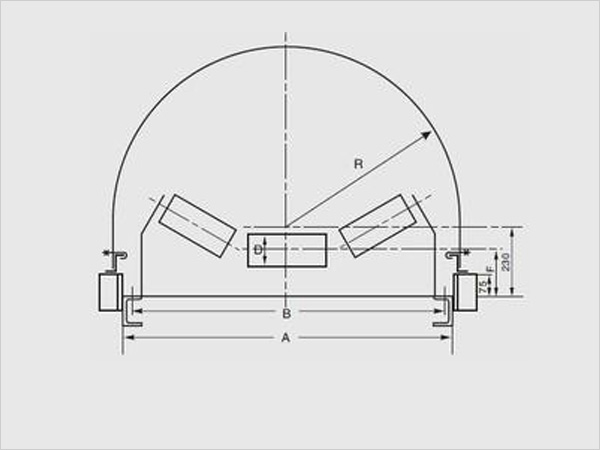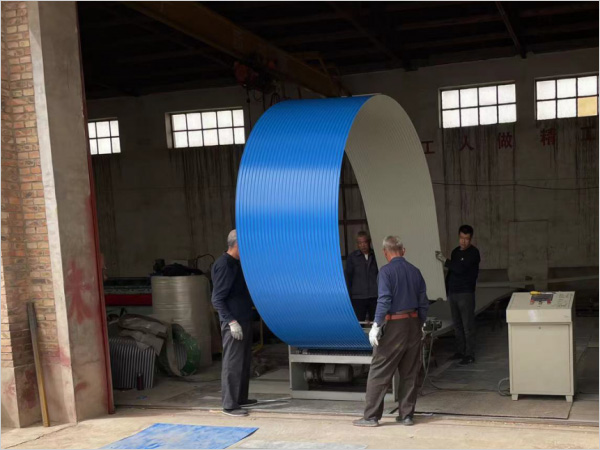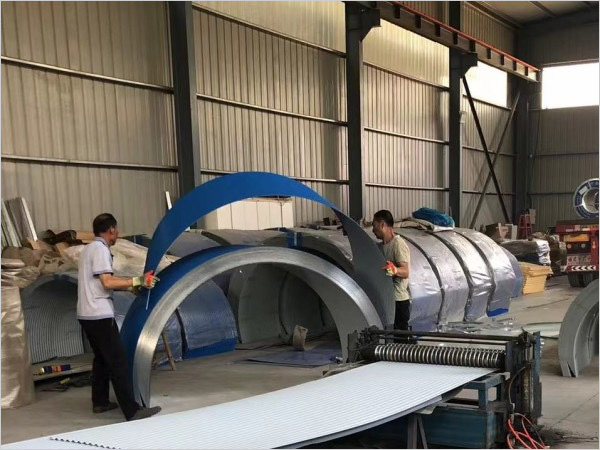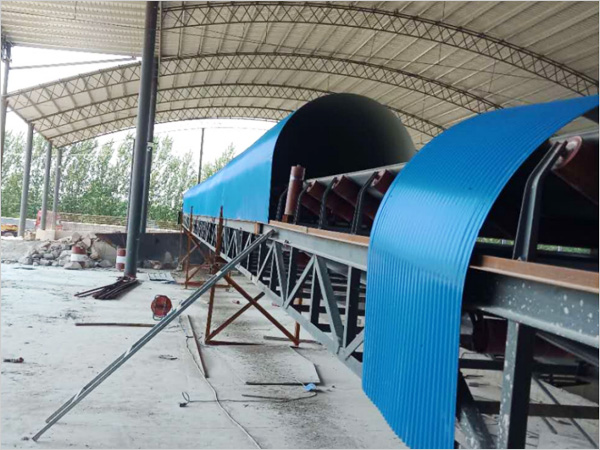Belt Conveyor Dust CoverApplication Industry
1. Industrial Production Workshop: In Electronic Manufacturing Workshops, The Production Process Requires Extremely High Environmental Cleanliness. When Conveying Electronic Components On A Belt Conveyor, A Dust Cover Can Prevent Dust From Adhering To The Components, Avoiding Quality Problems Such As Short Circuits And Poor Contact Caused By Dust, And Ensuring High-precision Production Of Electronic Products. In The Chemical Production Workshop, When Transporting Powdered Or Granular Chemical Raw Materials, Dust Covers Can Prevent The Raw Material Dust From Flying, Avoid Mutual Pollution Of Different Chemical Substances, And Ensure The Accuracy And Safety Of The Production Process.
2. Mines And Quarries: Belt Conveyors In Mines Transport A Large Amount Of Ore, And Dust Covers Can Suppress The Dust Generated During The Transportation Process. On The One Hand, Reducing Pollution To The Working Environment In Mining Areas, Protecting The Physical Health Of Miners, And Reducing The Risk Of Occupational Diseases Such As Pneumoconiosis; On The Other Hand, To Prevent Dust From Accumulating Around The Equipment And Affecting The Normal Operation Of Other Equipment, And To Improve The Stability Of The Entire Mining Production System.
3. Grain Storage And Processing Facilities: In Grain Warehouses, Belt Conveyors Are Used To Transport Grain. Dust Cover Can Prevent External Dust From Entering The Grain, Ensuring The Cleanliness Of The Grain And Meeting Food Hygiene Standards. At The Same Time, It Is Necessary To Avoid The Spread Of Grain Dust In The Warehouse, Reduce The Potential Danger Of Dust Explosion, And Ensure The Safety Of The Storage And Processing Environment.
Dust Cover Function Of Belt Conveyor
1. Efficient Dust Prevention: The Dust Cover Tightly Wraps Around The Belt Conveyor, Forming An Effective Sealed Space To Prevent Dust From Spreading Into The Surrounding Environment From The Source. The Sealing Materials And Structural Design Used Can Minimize Dust Leakage And Maintain Clean Air In The Work Area.
2. Equipment Protection: Dust Entering The Interior Of The Belt Conveyor Will Intensify The Wear And Tear Of Components Such As Belts, Rollers, And Idlers, Reducing The Service Life Of The Equipment. Dust Covers Can Prevent Dust From Entering, Reduce Internal Wear And Tear Of Equipment, Lower Maintenance Frequency And Costs, Ensure Long-term Stable Operation Of Conveyors, And Improve Production Efficiency.
3. Environmental Protection And Energy Conservation: Reducing Dust Emissions Helps Companies Meet Environmental Regulations And Avoid Penalties For Dust Pollution. In Addition, Preventing Material Dust From Flying And Causing Material Loss Improves The Utilization Rate Of Materials, Indirectly Achieving The Goal Of Energy Conservation And Efficiency Improvement. Pay Attention To Installing The Processed Boards Onto The Support Frame In The Designed Order. Use Self Tapping Screws Or Rivets To Connect And Fix The Board To The Frame, Paying Attention To The Tight Splicing Between The Boards To Avoid Gaps.
Installation Instructions: Weld Galvanized Angle Iron And Galvanized Z-shaped Purlins On Both Sides Of The Conveyor Belt Truss, Place The Conveyor Cover On Top, And Then Fix It With Hook Nails This Installation Method Is Sturdy And Durable. (2) Galvanized Angle Iron Is Welded On Both Sides Of The Conveyor Belt Truss, And The Conveyor Cover And Angle Iron Are Fixed With Drill Tail Wire. Two Installation Methods, Choose The One That Suits Your Own Enterprise
Note: Z-shaped Purlin Is 3 Meters Long, Hook Nail Specification Is M6, Angle Iron Is 30 * 30 * 2, 10 Cm Per Section
Specifications:

Product Code | ApplySkinBelt Width(Mm) | Belt Conveyor Related Dimensions (mm) DFBA
| Fixed Cover (mm) LWTR1
| Open The Cover (mm) LWTR1
| |||||||||
YDT5 | Five Hundred | Eighty-nine | One Hundred And Twenty-five | Seven Hundred And Forty | Eight Hundred | Nine Hundred And Ten | Eight Hundred And Forty-six | Five Hundred And Seventy-three | Four Hundred And Twenty-three | Nine Hundred And Ten | Eight Hundred And Forty-six | Five Hundred And Seventy-three | Four Hundred And Twenty-three |
YDT6 | Six Hundred And Fifty | One Hundred And Eight | One Hundred And Thirty-one | Eight Hundred And Ninety | Nine Hundred And Fifty | Nine Hundred And Ten | 12 Hours A Day 6 Days A Week | Six Hundred And Forty-eight | Four Hundred And Ninety-eight | Nine Hundred And Ten | 12 Hours A Day 6 Days A Week | Six Hundred And Forty-eight | Four Hundred And Twenty-nine |
YDT8 | Eight Hundred | One Hundred And Eight | One Hundred And Fifty-three | One Thousand And Ninety | One Thousand One Hundred And Fifty | Nine Hundred And Ten | One Thousand One Hundred And Ninety-six | Seven Hundred And Forty-eight | Five Hundred And Ninety-eight | Nine Hundred And Ten | One Thousand One Hundred And Ninety-six | Seven Hundred And Forty-eight | Five Hundred And Ninety-eight |
YDT10 | One Thousand | One Hundred And Thirty-three | One Hundred And Eighty-three Point Five | One Thousand Two Hundred And Ninety | One Thousand Three Hundred And Fifty | Nine Hundred And Ten | One Thousand Three Hundred And Ninety-six | Eight Hundred And Forty-eight | Six Hundred And Ninety-eight | Nine Hundred And Ten | One Thousand Three Hundred And Ninety-six | Eight Hundred And Forty-eight | Six Hundred And Ninety-eight |
YDT12 | One Thousand And Two Hundred | One Hundred And Thirty-three | One Hundred And Eighty-three Point Five | One Thousand Four Hundred And Ninety | One Thousand Five Hundred And Seventy | Nine Hundred And Ten | One Thousand Six Hundred And Six | Nine Hundred And Fifty-three | Eight Hundred And Three | Nine Hundred And Ten | One Thousand Six Hundred And Six | Nine Hundred And Fifty-three | Eight Hundred And Three |
YDT14 | One Thousand And Four Hundred | One Hundred And Fifty-nine | Two Hundred And Fifty-three Point Five | One Thousand Seven Hundred And Thirty | One Thousand Eight Hundred And Ten | Nine Hundred And Ten | One Thousand Eight Hundred And Fifty-six | One Thousand And Seventy-eight | Nine Hundred And Twenty-eight | Nine Hundred And Ten | One Thousand Eight Hundred And Fifty-six | One Thousand And Seventy-eight | Nine Hundred And Twenty-eight |
YDT16 | One Thousand And Six Hundred | One Hundred And Fifty-nine | Two Hundred And Fifty-three Point Five | One Thousand Nine Hundred And Thirty | Two Thousand And Ten | Nine Hundred And Ten | Two Thousand And Fifty-six | One Thousand One Hundred And Seventy-three | One Thousand And Twenty-eight | Nine Hundred And Ten | Two Thousand And Fifty-six | One Thousand One Hundred And Seventy-eight | One Thousand And Twenty-eight |
YDT18 | One Thousand And Eight Hundred | One Hundred And Fifty-nine | Two Hundred And Eighty-three Point Five | Two Thousand And Two Hundred | Two Thousand Two Hundred And Eighty | Nine Hundred And Ten | Two Thousand And Three Hundred | One Thousand Two Hundred And Eighty | One Thousand One Hundred And Fifty | Nine Hundred And Ten | Two Thousand And Three Hundred | One Thousand Two Hundred And Eighty | One Thousand One Hundred And Fifty |
YDT20 | Two Thousand | One Hundred And Fifty-nine | Two Hundred And Eighty-three Point Five | Two Thousand Four Hundred And Twenty | Two Thousand And Five Hundred | Nine Hundred And Ten | Two Thousand Five Hundred And Forty-six | One Thousand Four Hundred And Twenty-three | One Thousand Two Hundred And Seventy-three | Nine Hundred And Ten | Two Thousand Five Hundred And Forty-six | One Thousand Four Hundred And Twenty-three | One Thousand Two Hundred And Seventy-three |

Method For Measuring The Size Of The Conveyor Hood:
1. Width: Use A Tape Measure To Measure Horizontally At The Widest Point Of The Belt To Obtain The Width Of The Belt. This Is The Key Basis For Designing The Internal Width Of The Dust Cover, Ensuring That The Dust Cover Can Completely Cover The Belt. Generally, The Internal Width Of The Dust Cover Should Be 5-10 Centimeters Wider Than The Belt To Prevent Dust From Rising Out When Materials Overflow.
-Length: Measure The Length Of The Belt Between The Head And Tail Ends Of The Conveyor Along The Direction Of Belt Movement, Providing Reference For The Length Of The Dust Cover. However, Considering That The Conveyor May Have Special Parts Such As Bends And Transitions, The Actual Length Of The Dust Cover Needs To Be Reasonably Extended On This Basis, Generally By 10% -20%, To Ensure Full Stroke Protection.
2. Conveyor Frame:
-Height: Measure Vertically From The Bottom Support Surface Of The Conveyor To The Highest Point At The Top Of The Frame To Understand The Overall Height Of The Frame, In Order To Determine The Height Of The Dust Cover And Ensure Sufficient Space Inside To Accommodate The Operation Of The Belt And Rollers. Usually, The Height Inside The Dust Cover Should Be 15-30 Centimeters Higher Than The Highest Point Of The Frame.
-Width: Measure The Distance Between The Outermost Ends Of The Conveyor Frame On Both Sides, Which Helps Determine The Lateral Dimensions Of The Dust Cover And Ensures That It Can Wrap Around The Frame. Generally, The Outer Width Of The Dust Cover Is 10-20 Centimeters Wider Than The Frame.
3. Roller And Idler:
-Drum Diameter: Measure The Diameter Of Each Drum, And Reserve Appropriate Space For The Dust Cover At The Drum To Avoid Interference. Generally, The Distance Between The Dust Cover And The Edge Of The Drum Should Be Kept At 10-15 Centimeters.
-Roller Spacing And Height: Measure The Distance Between Adjacent Rollers, As Well As The Height From The Top Of The Rollers To The Bottom Of The Frame, Which Helps Determine The Shape And Height Of The Bottom Of The Dust Cover, Ensuring That The Bottom Of The Dust Cover Is Compatible With The Rollers And Does Not Affect Their Rotation.
4. Special Parts:
-Turning Point: If The Conveyor Has A Turning Point, It Is Necessary To Measure The Turning Radius, Angle, And The Length Difference Between The Inside And Outside Of The Belt At The Turning Point. The Dust Cover At The Turning Point Should Be Specially Designed To Ensure A Tight Fit And Not Affect The Turning Of The Belt, Such As Using Bendable Materials Or Segmented Splicing Design
Chinese Manufacturer, Welcome To The Factory.
Factory Direct Sales Savings: By Purchasing Directly From Our Factory, You Can Save A Significant Amount Of Costs. Our Streamlined Supply Chain Eliminates Intermediaries, Allowing Us To Offer Competitive Prices Without Compromising Quality.
Batch Order Discount: For Large Projects Or Industrial Applications, We Offer Significant Discounts For Bulk Orders. Please Contact Us To Discuss Your Specific Requirements And Obtain A Customized Quotation That Is Suitable For Your Budget And Project Scale





